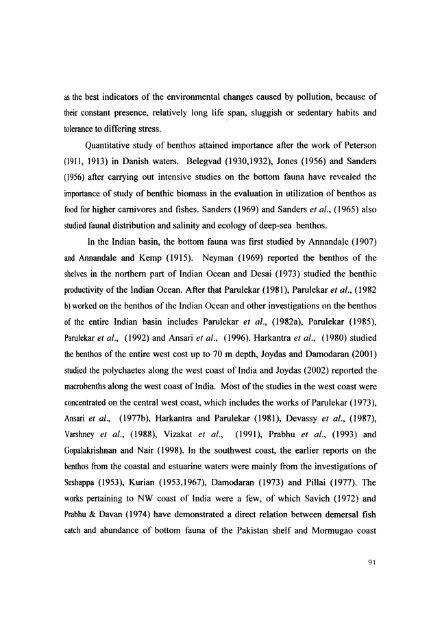L - Cochin University of Science and Technology
L - Cochin University of Science and Technology
L - Cochin University of Science and Technology
Create successful ePaper yourself
Turn your PDF publications into a flip-book with our unique Google optimized e-Paper software.
as the best indicators <strong>of</strong> the environmental changes caused by pollution, because <strong>of</strong><br />
their constant presence, relatively long life span, sluggish or sedentary habits <strong>and</strong><br />
tolerance to differing stress.<br />
Quantitative study <strong>of</strong> benthos attained importance after the work <strong>of</strong> Peterson<br />
(l911, 1913) in Danish waters. Belegvad (1930,1932), Jones (1956) <strong>and</strong> S<strong>and</strong>ers<br />
(1956) after carrying out intensive studies on the bottom fauna have revealed the<br />
importance <strong>of</strong> study <strong>of</strong> benthic biomass in the evaluation in utilization <strong>of</strong> benthos as<br />
food for higher carnivores <strong>and</strong> fishes. S<strong>and</strong>ers (1969) <strong>and</strong> S<strong>and</strong>ers et al., (1965) also<br />
studied faunal distribution <strong>and</strong> salinity <strong>and</strong> ecology <strong>of</strong> deep-sea benthos.<br />
In the Indian basin, the bottom fauna was first studied by Ann<strong>and</strong>ale (1907)<br />
<strong>and</strong> Ann<strong>and</strong>ale <strong>and</strong> Kemp (1915). Neyman (1969) reported the benthos <strong>of</strong> the<br />
shelves in the northern part <strong>of</strong> Indian Ocean <strong>and</strong> Desai (1973) studied the benthic<br />
productivity <strong>of</strong> the Indian Ocean. After that Parulekar (1981), Parulekar et al., (1982<br />
b) worked on the benthos <strong>of</strong> the Indian Ocean <strong>and</strong> other investigations on the benthos<br />
<strong>of</strong> the entire Indian basin includes Parulekar et al., (1982a), Parulekar (1985),<br />
Parulekar et al., (1992) <strong>and</strong> Ansari et al., (1996). Harkantra et al., (1980) studied<br />
the benthos <strong>of</strong> the entire west cost up to 70 m depth, Joydas <strong>and</strong> Damodaran (2001)<br />
studied the polychaetes along the west coast <strong>of</strong> India <strong>and</strong> Joydas (2002) reported the<br />
macrobenths along the west coast <strong>of</strong> India. Most <strong>of</strong> the studies in the west coast were<br />
concentrated on the central west coast, which includes the works <strong>of</strong> Parulekar (1973),<br />
Ansari et al., (1977b), Harkantra <strong>and</strong> Parulekar (1981), Devassy et al., (1987),<br />
Varshney et al., (1988), Vizakat et al., (1991), Prabhu et al., (1993) <strong>and</strong><br />
Gopalakrishnan <strong>and</strong> Nair (1998). In the southwest coast, the earlier reports on the<br />
benthos from the coastal <strong>and</strong> estuarine waters were mainly from the investigations <strong>of</strong><br />
Seshappa (1953), Kurian (1953,1967), Damodaran (1973) <strong>and</strong> Pillai (1977). The<br />
works pertaining to NW coast <strong>of</strong> India were a few, <strong>of</strong> which Savich (1972) <strong>and</strong><br />
Prabhu & Davan (1974) have demonstrated a direct relation between demersal fish<br />
catch <strong>and</strong> abundance <strong>of</strong> bottom fauna <strong>of</strong> the Pakistan shelf <strong>and</strong> Morrnugao coast<br />
91

















